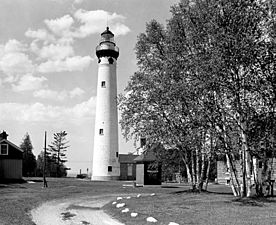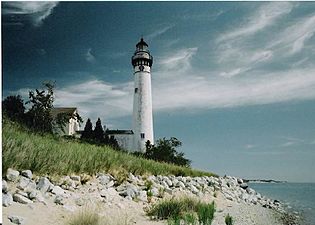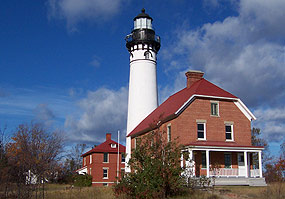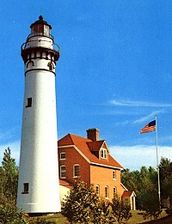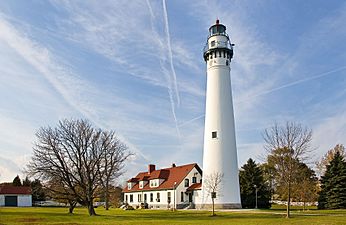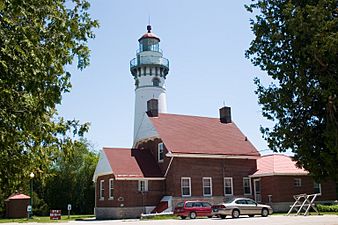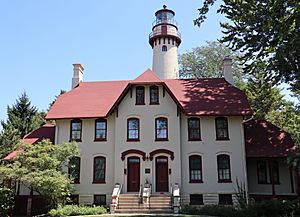Grosse Point Light facts for kids
The historic Grosse Point Light is a famous lighthouse located in Evanston, Illinois. After several ship accidents near Evanston, local residents asked the government for help. They wanted a lighthouse to guide ships safely. Construction of the lighthouse was finished in 1873. The light first shone in 1874.
The Grosse Point Light was added to the National Register of Historic Places on September 8, 1976. It was later named a National Historic Landmark on January 20, 1999. Today, the lighthouse is managed by the Evanston Lighthouse Park District, a local group.
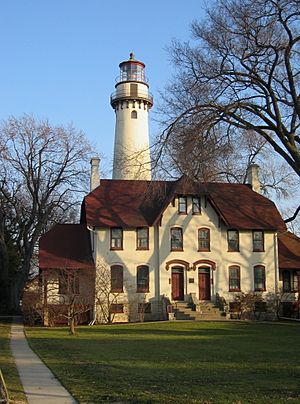 |
|
| Grosse Point Light Station | |
|
|
|
| Location | 2601 Sheridan Rd., Evanston, Illinois |
|---|---|
| Coordinates | 42°3′50″N 87°40′34″W / 42.06389°N 87.67611°W |
| Year first constructed | 1873 |
| Year first lit | 1874 |
| Automated | 1935 |
| Deactivated | 1941 but reactivated 1946 as Private Aid to Navigation |
| Foundation | Stone/Concrete |
| Construction | Cream City Brick encased in concrete Italianate bracketing |
| Tower shape | Frustum of a Cone tower attached to storage building |
| Markings / pattern | yellow w/red trim & red roof |
| Height | 113 ft (34 m) |
| Focal height | 119 feet (36 m) |
| Original lens | Second order Fresnel lens |
| Current lens | Second order Fresnel lens |
| Intensity | 68,000 candlepower |
| Range | Original: 18 nautical miles; 34 kilometres (21 mi) |
| Characteristic | 2 white flashes every 15 seconds |
| ARLHS number | USA-359 |
| USCG number | 7-20190 |
Contents
The Lighthouse Story
Why Was It Built?
The United States government decided to build the lighthouse at Grosse Point because of many ship accidents nearby. Hidden sandbanks, called shoals, were a big danger to ships. More and more ships were traveling on the Great Lakes as the Midwest grew. The city of Chicago was also growing fast, especially after the Chicago Fire in 1871. This meant more trade and more ships.
A very sad event, the sinking of the Lady Elgin in 1860, was especially important. Over 300 people lost their lives in that disaster. The people of Evanston asked the government for a lighthouse. However, the American Civil War (1861-1865) delayed the project. Lighthouses closer to Chicago were not enough, so a new one was clearly needed.
Building the Lighthouse
Work on the lighthouse began in 1872. It was built under the watch of Orlando Metcalfe Poe, an engineer. Most of the construction was finished by June 30, 1873. However, the lamp was not lit for several more months. Finally, in March 1874, the light began to shine. The building was designed in the Italianate style, which was popular then.
Colonel Poe was a chief engineer for the United States Lighthouse Board. He designed several lighthouses around the Great Lakes. The Grosse Point Light is one of these "Poe style lighthouses."
Turning the Light Off and On Again
In 1935, the government gave the lighthouse grounds and buildings (but not the tower and light) to the city of Evanston. In 1941, the United States Coast Guard turned off the Grosse Point Light. This was a safety step in case of air raids after the attack on Pearl Harbor. After the light was turned off, the city received the tower and the light. But the government can take the light station back if they ever need it.
The light was turned back on in 1945. It has been used as a helpful guide for ships ever since. The Lighthouse Park District of Evanston, Illinois, now runs the lighthouse. This group used to be called the Northeast Park District, but it changed its name to honor the lighthouse.
How It Was Built
The Light Tower
The main part of the Grosse Point Light is its tall, cone-shaped tower. The tower stands on a strong concrete base. This base has wooden poles that go 30 feet (9.1 m) deep into the ground. The tower has two outer walls with a space between them. The inner wall is 8 inches (200 mm) thick and goes straight up. The outer wall is 12 inches (300 mm) thick and slopes slightly, giving the tower its cone shape. The tower is 22-foot (6.7 m) around at its bottom and 13 feet 3 inches (4.04 m) around at the top. The top part of the tower, where the light shines, is made of glass and iron. It has a copper roof.
The Lantern and Lens
The lighthouse uses a special lens called a second order Fresnel lens. This is one of the largest lenses ever placed on the Great Lakes. This shows how important this light was. The lens was made by the Henry-Lepaute Company in Paris. It is still in place today, which is very rare. It is said to be the only second order Fresnel lens still working and in its original spot on the Great Lakes.
This lens is one of only about 70 such Fresnel lenses still working in the United States. Sixteen of these are on the Great Lakes, with eight of them in Michigan.
Grosse Point Legends
Some stories say that Father Jacques Marquette landed at the site of the Grosse Point Lighthouse in 1674. This was during his trip down the west side of Lake Michigan to visit different Native American tribes in Illinois. However, this is mostly a story. There is no real historical proof that this actually happened.
What's Happening Now
The Grosse Point Light is about 13 miles (21 km) north of Chicago. It is just north of Northwestern University. Even though it is outside Chicago, people say: "The keeper's house is Chicago's only maritime museum." One building that used to hold the fog signal is now a visitor center. Another building holds a nature center. The keeper's house and the tower are open for tours on summer weekends.
Images for kids



